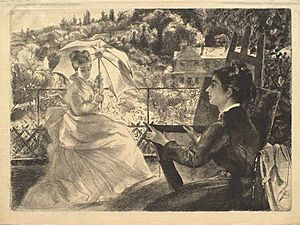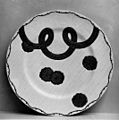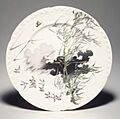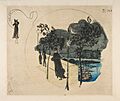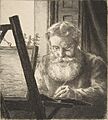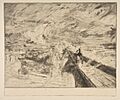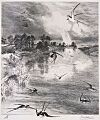Félix Bracquemond facts for kids
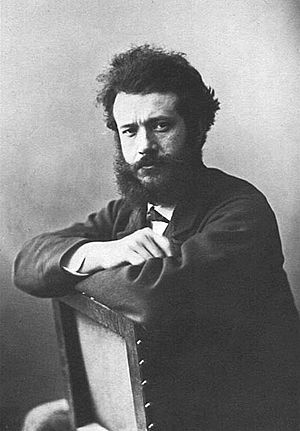
Félix Henri Bracquemond (born May 22, 1833 – died October 29, 1914) was a talented French artist. He was a painter, an etcher (someone who makes prints using acid on metal), and a printmaker (someone who creates art by printing images).
Félix Bracquemond was very important in bringing back the art of printmaking. He encouraged famous artists like Édouard Manet, Edgar Degas, and Camille Pissarro to try this technique.
He also designed pottery, which was unusual for a well-known artist at the time. His pottery designs were very new and helped start a style called Japonisme in France. This style was inspired by Japanese art.
Félix Bracquemond was married to the Impressionist painter Marie Bracquemond.
Contents
About Félix Bracquemond
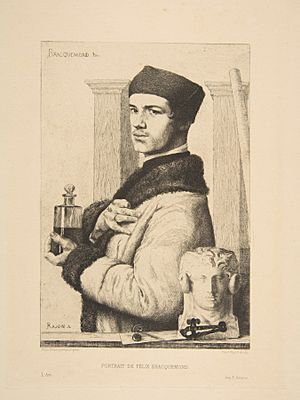
His Early Life and Training
Félix Bracquemond was born in Paris, France. When he was young, he learned to be a lithographer, which is a type of printmaker. Later, he studied art with Joseph Guichard, who was a student of the famous painter Ingres.
When Félix was just 19, he painted a portrait of his grandmother. This painting caught the eye of a famous writer named Théophile Gautier at an art show called the Salon.
Becoming a Master Engraver
Félix Bracquemond didn't paint a lot of pictures. He was much more interested in engraving and etching. He learned most of his technical skills by himself, often studying books like the Encyclopédie by Diderot and d'Alembert.
Around 1853, he started focusing on engraving and etching. He became a very important and brilliant artist in bringing back etching in France. Overall, he created more than 800 different prints! These included portraits, landscapes, scenes from everyday life, and studies of birds. He also made prints based on paintings by other artists, like Jean-Louis-Ernest Meissonier and Jean-Baptiste-Camille Corot.
Félix Bracquemond became friends with many important writers and artists of his time, including Charles Baudelaire, Théodore de Banville, and Auguste Rodin.
In 1856, he became close friends with Edmond de Goncourt. They both loved Japanese art. Félix was actually one of the first people to discover an art book by the Japanese artist Hokusai.
In 1862, he joined a group called the Société des aquafortistes (Society of Etchers). Because of his advice, many famous artists like Jean-Baptiste Corot, Jean-François Millet, Édouard Manet, Edgar Degas, and Camille Pissarro started making etchings. He helped Manet a lot with his etchings for famous paintings like Olympia.
Later, in 1888, Félix Bracquemond helped create a magazine called L'Estampe originale. This magazine aimed to get artists and art lovers interested in new ways of engraving, especially color prints.
His Connection to the Impressionists
In 1874, Félix Bracquemond took part in the very first exhibition of a group of painters who would later be called the Impressionists. This show happened in the studios of Nadar in Paris. The exhibition opened on April 15, 1874, and caused quite a stir!
At this show, Bracquemond displayed a portrait and a collection of his etchings. These included portraits of famous people like Auguste Comte and Charles Baudelaire. He also showed etchings he made based on works by Turner, Ingres, and Manet, as well as his own original etchings like Les Saules (The Willows). He exhibited his work with these friends again in 1879.
Designing Pottery and Japonisme
In 1856, Félix Bracquemond made an exciting discovery. He found a collection of Manga engravings by the Japanese artist Hokusai. These prints showed flowers, birds, insects, and fish, a style known as Kachô-ga in Japan. He found them in his printer's workshop, where they had been used as packing material for a shipment of porcelain.
This discovery inspired him greatly. In 1860, he started working for a ceramist (someone who makes pottery) named Théodore Deck, and then for a pottery seller named Eugène Rousseau in Paris. Rousseau asked him to design patterns for a special dinner service for the Universal Exhibition of 1867.
Bracquemond suggested a design that used the themes from the Japanese Kachô-ga prints. He drew and engraved these designs himself. This was the first time a European artist directly copied a Japanese artist's animal figures from the Hokusai Manga.
Eugène Rousseau loved the idea and ordered 200 pieces of pottery to be made. Bracquemond created the etchings and engraved plates that the factory used. The designs were then transferred onto the clay. When the pottery was fired in the oven, the paper disappeared, leaving only the drawing's imprint. Then, the pieces were painted and fired again.
This dinner service was shown for the first time at the Universal Exhibition of 1867 and was a huge success! People could even choose which pieces they wanted to make their own unique set. For example, Rousseau suggested "barnyard animals for meat, crustaceans for fish, and flowers for dessert." This service was also designed to be enjoyed by different kinds of people, from wealthy families to the nobility.
Many artists and writers at the time praised this beautiful pottery service. The famous poet Mallarmé especially admired it, calling it "the most beautiful crockery I have ever known." He said that Bracquemond had brought a "high Japanese charm" to French ceramics.
Félix Bracquemond also worked for the Manufacture nationale de Sèvres, a famous French porcelain factory, in 1870. His work there helped lead to the modern style of art. He also became the artistic director for a Parisian studio of the Charles Haviland company from Limoges.
Later Life and Other Works
Félix Bracquemond was a close friend of artists like Édouard Manet, James McNeill Whistler, and Henri Fantin-Latour. He even appears in some of Fantin-Latour's paintings, such as Hommage à Delacroix (1864).
He married Marie Quivoron, who was also a painter, in 1869. She became known as Marie Bracquemond. Sadly, their son, Pierre, said that Félix was often jealous and critical of Marie's artwork, which eventually led her to stop painting.
Félix Bracquemond also wrote a book called Du dessin et la couleur (About Drawing and Color) in 1886, which was highly praised by Vincent van Gogh. He also wrote studies on woodcutting and lithography.
Some of his best engravings show landscapes or animals, like Reeds and teals (1882), Les Hirondelles (The Swallows, 1882), and Les Mouettes (The Seagulls, 1888).
He was recognized for his achievements and was made an Officer of the Legion of Honor in 1889, a very important award in France.
Art historian Gabriel P. Weisberg called him the "molder of artistic taste in his time." This means he greatly influenced what people considered good art. He was the one who saw the beauty in the Hokusai woodcuts used as packing material, a discovery that helped change the look of art in the late 1800s.
Félix Bracquemond passed away in Sèvres.
Images for kids
-
Portrait of Ferdinand Lesseps, 1850–1914
-
Frontispiece for Oeuvres Nouvelles de Champfleury (after Courbet), 1860–98
-
Simon Lantara (after Vernet), for L'Artiste,
September 1864 -
The Locomotive (after Turner), 1873
-
Death Mask of
Auguste Blanqui, 1881 -
Portrait of
Edmond de Goncourt, 1882
See also
 In Spanish: Félix Bracquemond para niños
In Spanish: Félix Bracquemond para niños


